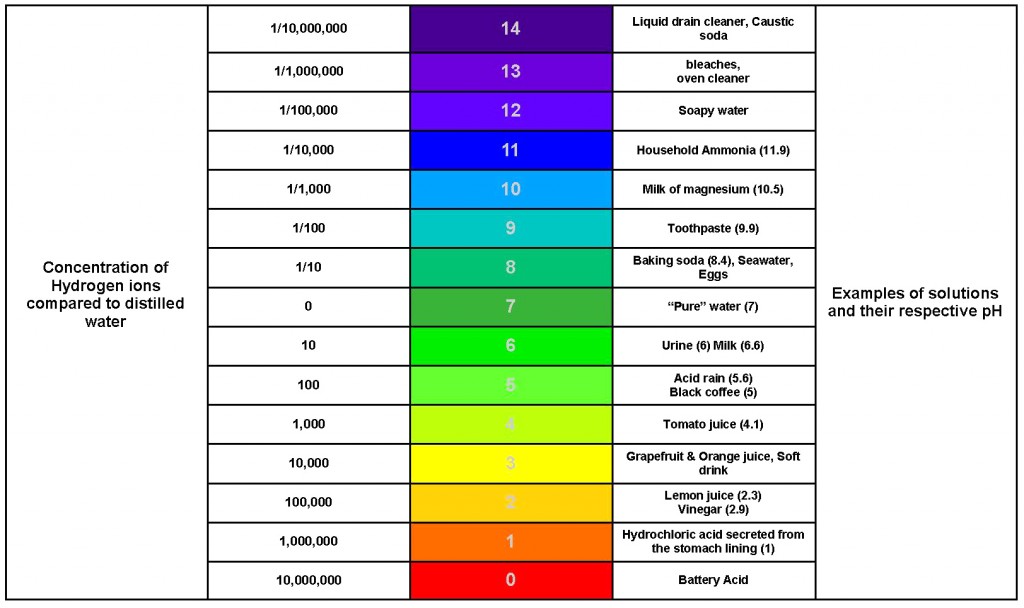Life depends on appropriate pH levels around and in living organisms and cells.
We requires a tightly controlled pH level in our serum of about 7.4 to avoid metabolic acidosis and survive. As a comparison, in the past 100 years the pH of the ocean has dropped from 8.2 to 8.1 because of increasing carbon dioxide deposition with a negative impact on life in the ocean.

Even the mineral content of the food we eat is considerable influenced by the pH of the soil in which plants are grown. The ideal pH of soil for the best overall availability of essential nutrients is between 6 and 7: an acidic soil below pH of 6 may have reduced magnesium and calcium, and soil above pH 7 may result in chemically unavailable zinc, iron, copper and manganese.
Metabolic acidosis and agricultural and industrial revolutions
In the human diet, there has been considerable change from the hunter gather civilization to the present in the pH and net acid load. With the agricultural revolution, in the last 10,000 years, and even more recently with industrialization, in the last 200 years, it has been seen:
- an increase in sodium compared to potassium, as the ratio potassium/sodium has reversed from 10 to 1 to a ratio of 1 to 3 in the modern diet, and in chloride compared to bicarbonate;
- a poor intake of magnesium and fiber;
- a large intake of simple carbohydrates and saturated fatty acids.
This results in a diet that may induce metabolic acidosis which is mismatched to the genetically determined nutritional requirements.
Moreover, with aging, there is a gradual loss of renal acid-base regulatory function and a resultant increase in diet-induced metabolic acidosis.
Finally, a high protein low-carbohydrate diet with its increased acid load results in very little change in blood chemistry, and pH, but results in many changes in urinary chemistry: urinary calcium, undissociated uric acid, and phosphate are increased, while urinary magnesium, urinary citrate and pH are decreased.
All this increases the risk for kidney stones.
pH as a protective barrier
The human body has an amazing ability to maintain a steady pH in the blood, with the main compensatory mechanisms being renal and respiratory.
pH levels in the body vary considerably from one area to another. The highest acidity is found in the stomach (pH of 1.35 to 3.5), aiding digestion and protecting against opportunistic microbial organisms.
Skin is quite acidic (pH 4–6.5), providing an acid mantle as a protective barrier against microbial overgrowth. This is also seen in the vagina, where a pH of less than 4.7 helps prevent microbial overgrowth.
The urine have a variable pH from acid to alkaline depending on the need for balancing the internal environment.
| Organ, Fluid or Membrane | pH | Function of pH |
|---|---|---|
| Skin (surface) | Natural pH is between 4 and 6.5 | Barrier protection from microbes |
| Urine | 4.6 to 8.0 | Limit overgrowth of microbes |
| Gastric fluid | 1.35 to 3.5 | Breakdown proteins |
| Bile | 7.6 to 8.8 | Neutralize stomach acid, aid in digestion |
| Pancreatic fluid | 8.8 | Neutralize stomach acid, aid in digestion |
| Vaginal fluid | <4.7 | Limit overgrowth of opportunistic microbes |
| Cerebrospinal fluid | 7.3 | Bathes the exterior of the brain |
| Intracellular fluid | 6.0 – 7.2 | Due to acid production in cells |
| Serum venous | 7.35 | Tightly regulated |
| Serum arterial | 7.4 | Tightly regulated |
| Modified from: Schwalfenberg G.K.; see in References | ||
References
- Fenton T.R., Lyon A.W., Eliasziw M., Tough S.C., Hanley D.A. Meta-analysis of the effect of the acid-ash hypothesis of osteoporosis on calcium balance. J Bone Miner Res 2009;24(11):1835-1840. doi:10.1359/jbmr.090515
- Fenton T.R., Lyon A.W., Eliasziw M., Tough S.C., Hanley D.A. Phosphate decreases urine calcium and increases calcium balance: a meta-analysis of the osteoporosis acid-ash diet hypothesis. Nutr J 2009;8:41. doi:10.1186/1475-2891-8-41
- Fenton T.R., Tough S.C., Lyon A.W., Eliasziw M., Hanley D.A. Causal assessment of dietary acid load and bone disease: a systematic review and meta-analysis applying Hill’s epidemiologic criteria for causality. Nutr J 2011;10:41. doi:10.1186/1475-2891-10-41
- Schwalfenberg G.K. The alkaline diet: is there evidence that an alkaline pH diet benefits health? J Environ Public Health 2012; Article ID 727630. doi:10.1155/2012/727630